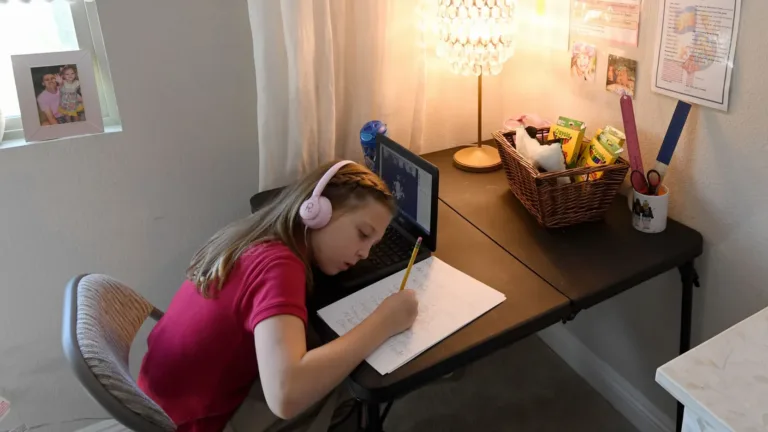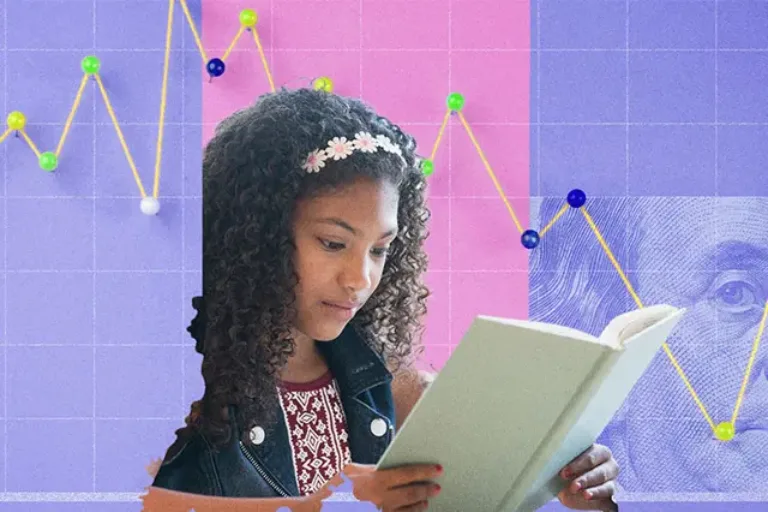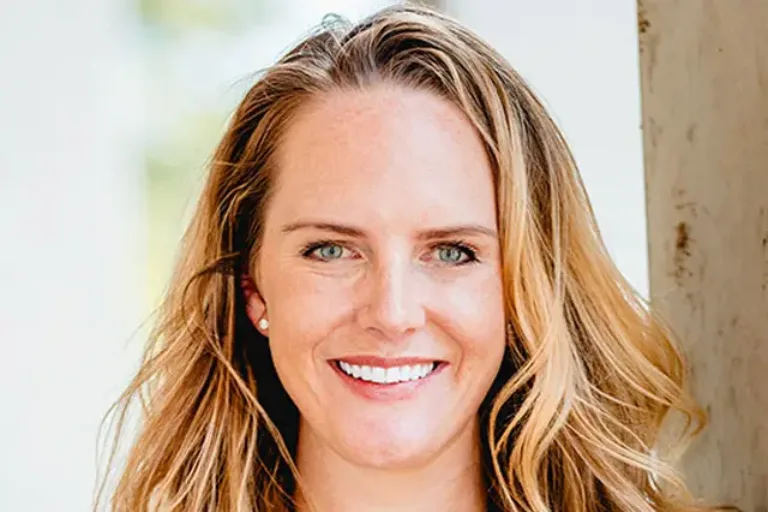Schools are spending millions on new virtual tutoring. Is it working?
Superintendent Scott Muri knew his students needed extra help with math and reading. But before he could launch a tutoring program, he needed tutors.
This was no small challenge in a district that already faced a staff shortage. Shortly before the pandemic began, one in five classrooms didn’t have a permanent teacher.
“I didn’t need just five or 10 tutors, I needed hundreds,” said Muri, who leads Ector County schools, a district of some 32,000 students in West Texas. “Virtual was our only option.”
So, with federal COVID relief dollars in hand, Ector County joined many other U.S. school districts in an informal nationwide experiment. Could virtual tutoring be a credible replacement for in-person help? And could it fill gaps for students who, in a brutal irony, had lost ground when school was fully online?
The district spent more than $5 million last year to find out, paying for tutors to work one-on-one with 6,000 students virtually during the school day. Officials are still analyzing the results. Muri says students who got a lot of help outpaced their peers academically, but schools will make adjustments next year, especially for younger students.
“It is something that we will continue, hopefully in perpetuity,” Muri said.
Elsewhere, some schools turning to virtual tutoring have struggled to get students to participate, particularly the students who need the most support. Communication between tutors and teachers can be spotty, and the scheduling logistics are complex. The setup has frustrated some students, especially those who only got text- or chat-based help.
Most critically, the academic impact of pandemic-era virtual tutoring is still largely unknown. Still, it’s an unprecedented expansion of academic support, with more and more companies looking to become part of districts’ recovery plans — and a more permanent fixture in schools.
“We know that tutoring works, and we’ve seen different models that are effective, but there is still a lot of disagreement about how to get that done,” said Janice Jackson, the former Chicago schools chief who now chairs the board of Accelerate, a nonprofit focused on tutoring strategies. “We have a lot of tutoring companies in the ed tech space that are offering things that are more economical. But the jury is still out on their effectiveness.”
This school year marked the first time that many school districts attempted virtual tutoring on a large scale. Fueling this growth: Schools have billions in federal relief dollars, and must spend a chunk of that money helping students who fell behind academically.
An entire industry has cropped up in response, which now includes some longtime players and several companies that have pivoted from offering expensive private tutoring.
Their services can be divided into two main categories. The first is “on-demand” tutoring, which operates like homework help and matches students with a new tutor each time they log on.
The company Paper, for example, has students upload pictures of their work or type questions into a chat box. Students can type and talk to tutors over Tutor.com, and they can see and hear tutors through TutorMe. Those two companies allow students to “favorite” a tutor, but that tutor may not be available when the student needs help the next time.
The other approach pairs students with one tutor for multiple virtual sessions each week. It’s similar to the kind of “high-dosage” help that’s been shown to deliver strong results in person.
The small handful of studies that have looked at virtual tutoring during the pandemic saw promising results from this variety. But offerings vary, so it’s tough to say how many students are getting that kind, said Matthew Kraft, an associate professor of education at Brown University who’s studying tutoring initiatives.
“It’s way premature to start saying: ‘Oh, it’s working here, it’s not working there,’” Kraft said. “I would be hard-pressed to name very many districts who would raise their hand and say: ‘Yeah, ours is just knocking it out of the park, we’ve got it figured out.’”
That’s left district leaders to sort through pitches for all kinds of virtual tutoring products. Brenda Lewis, an assistant superintendent for Grand Forks schools in North Dakota, has seen how much the quality can vary. She worked with a team to vet a half-dozen virtual tutoring providers before landing on Littera Education, which connects students and tutors on live video.
“It’s overwhelming at first,” Lewis said. Some companies “are really amazing and have the data to back it up, and others aren’t.”
Ten-year-old Alisma Meyer was among the first to try out the reading tutoring.
On a recent Wednesday morning at her elementary school, the rising fifth-grader scooted her chair close to a laptop and waited for her tutor’s face to appear. After they said hi, Alisma read aloud “Sleepy Barker,” a book about a dog awakened by noises in the night. Then Alisma’s tutor, Amanda Erdman, a former elementary school teacher, asked what Alisma noticed.
“I’ve improved at reading faster,” Alisma said.
“You have improved with reading faster and more fluently,” Erdman agreed. “What is something that you think you still need to work on as a reader that you think we can work on together?”
“Sometimes I need to work on longer words,” Alisma replied.
Then Erdman guided Alisma through an exercise in identifying letter sounds. Listening nearby, the school’s instructional coach could tell Alisma recognized more vowel groups than earlier in the year. Alisma saw progress, too, noticing that her hands no longer shake when she reads in front of her classmates.
“It’ll teach you stuff but it’s also fun,” Alisma said of virtual tutoring. “It’s kind of the premise of school.”
Alisma’s experience with virtual tutoring is what schools are aiming for. But it doesn’t always go that smoothly, and the offerings have raised questions about access and engagement — concerns that dogged schools when classes were remote during the pandemic.
When the school board in Palm Beach County, Florida debated renewing a $1.1 million contract with Paper in May, board member Debra L. Robinson pointed out that there had been a “huge disparity in usage.” Schools with higher poverty rates were using the on-demand tutoring less. (A district official said they’d worked to let more parents, teachers, and students know about the service, and the board reupped the contract for another $2.9 million.)
Participation in virtual tutoring has been relatively low in Akron, Ohio since the district launched its service in January. The district bought 5,000 virtual tutoring hours from TutorMe for just under $133,000, but after six months, students had used only 500 tutoring hours. All middle and high schoolers had access to the tutoring, but just about one in 11 students used it.
Marcie Ebright, a digital learning specialist for the district, said it was challenging to roll out a new service mid-year, but she hopes that more students will use the tutoring after the district promotes it this fall. Staff also will be analyzing which students used the service “so that we can more actively target the audiences that may need it,” Ebright said.
“Our early adopters are always going to be those kids that are seeking out that extra support to do better at school,” she said. If “we don’t really see the numbers increasing, and kids aren’t really taking advantage of it like we had hoped, then it might be something that we retire.”
In Hillsborough County, Florida, which also has a contract with Paper for just under $2.7 million, board member Karen Perez worried the service wouldn’t be as helpful for the many students without a computer or reliable internet at home. (Officials said they could provide laptops or the student could visit a library.)
Perez, who learned English as a second language, also had concerns that the limited interaction over text-based chat would be frustrating for English learners.
“For me, the population who is unable to access those services are the ones who usually need it the most,” she said. “If you’re looking at the tutoring but not putting the supports in place for the students to move forward and progress, then you’re just basically setting up the students to fail.”
Researchers who study tutoring have similar concerns. Susanna Loeb, a professor of education who directs the Annenberg Institute at Brown University, says virtual tutoring is likely most effective when students are getting that help during the school day at regularly scheduled sessions.
“Once the students aren’t in school, it’s not that the interaction isn’t effective when it’s there, it’s that it’s difficult to get students to show up, particularly the students who are most disengaged with school,” Loeb said. “Student opt-in just is not an equalizing approach.”
For their part, companies that offer on-demand virtual tutoring say there are benefits to their model.
Phil Cutler, the CEO of Paper, said many students like being able to work with a tutor at a time that fits their schedule, and districts like paying a fixed price for an unlimited number of tutoring hours. “Every student has access and they can use it as much or as little as they want to,” he said, likening it to an “all-you-can-eat” option.
And some point out that districts are free to work with multiple companies to address students’ needs.
“We’re not going to be the best thing for every student, but we are going to be able to impact a large number of your students,” said Ryan Patenaude, the executive vice president of FEV Tutor, which provides text-based virtual tutoring to several large districts, including Ector County. “It can’t be a one-size-fits-all model.”
Virtual tutoring companies see this moment as an opportunity to become a more permanent offering. For the right price, many think — or at least hope — that schools will pay for virtual tutoring long after federal COVID relief dollars run out.
“It’s going to set expectations that are part of schools going forward,” said Anthony Salcito, who oversees virtual tutoring work at school districts for Varsity Tutors. “How do we think about being a partner to schools long-term, not just in this window right now?”
There’s a big incentive to get this right. Mississippi, for example, signed a nearly $10.8 million contract with Paper to provide on-demand tutoring to more than 100 districts across the state over the next two and a half years. Boston Public Schools will spend $5 million on Paper’s services over three years.
Prince George’s County schools in Maryland is spending $1.5 million for 10 months of TutorMe, while Wichita schools in Kansas is spending $2.5 million for a year of elementary school math tutoring from Varsity Tutors.
Schools are still trying to figure out how to get the best results for that money.
Denver Public Schools paid the company Cignition just under $700,000 this past school year to virtually tutor 880 students in math for at least 90 minutes a week. When staff interviewed students about their experience, they found elementary schoolers liked it more than older students — who sometimes got frustrated when they had to attend tutoring instead of a fun elective class.
Now, the district will only offer virtual tutoring to elementary and middle school students, while ninth graders will get in-person tutoring. And after some students complained about distracting setups at school, the district hired a coordinator who will ensure students have a quiet place to work.
The main thing to improve is collaboration between tutors and teachers, said Principal Laura Munro, who had 30 fourth and fifth graders participate this year and praised the program as engaging.
“How can we use the data from each session that kids are in to drive any adjustments in the classroom?” she said.
In Ector County, Principal Jessica Redman is looking forward to younger students being paired with tutors over video next year, after many of her elementary schoolers had a hard time with text-based tutoring. She’s also eager to get her hands on data that illustrates what exactly the effect of virtual tutoring was.
“It’s hard to know what the one factor was that helps the most,” Redman said. “We just did everything we could to get kids caught up.”
Kalyn Belsha is a national education reporter based in Chicago. Contact her at kbelsha@chalkbeat.org.
Chalkbeat is a nonprofit news site covering educational change in public schools.



